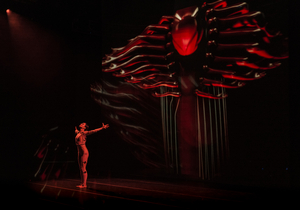Review: SLEEPING BEAUTY DREAMS KICKS OFF ITS TOUR IN NYC at Manhattan Center
 The first performance of a ten city/ten performance tour of the U.S. was given on November 2, 2019 at the Manhattan Center, 311 West 34th Street, NYC. I was excited to be in attendance. Afterall, Russian ballerina Diana Vishneva danced the role of the Princess, known in the original ballet of Sleeping Beauty as Aurora. I had not seen her perform since she left American Ballet Theatre (where she had been a principal dancer since 2005) in 2017; and I wanted to see her next project, a contemporary ballet with mixed media. It was surprising.
The first performance of a ten city/ten performance tour of the U.S. was given on November 2, 2019 at the Manhattan Center, 311 West 34th Street, NYC. I was excited to be in attendance. Afterall, Russian ballerina Diana Vishneva danced the role of the Princess, known in the original ballet of Sleeping Beauty as Aurora. I had not seen her perform since she left American Ballet Theatre (where she had been a principal dancer since 2005) in 2017; and I wanted to see her next project, a contemporary ballet with mixed media. It was surprising.
The first surprise was the loud, electronic music, composed by Thijs De Vlieger. The large theater vibrated: floor and chairs, as did I: chest and throat (quite literally). Other creative artists who contributed to this project are Edward Clug, Creative Director/Choreographer; Bart Hess, Costume Designer; and Tobias Gremmler, Digital Artist.
The projection on the scrim at the back of the stage was constantly changing: smoke, colors, filaments, metallic female figure, masks, many arms, and more, as in a dream. Vishneva at times seemed to lead the movement in the film, perhaps with the lights in bands around her unitard, white in the first act, metallic in the second act. Other times she seemed to have no effect on the projection, another surprise. At times I had to shift my focus to the dancers, as the media tended to overwhelm the live performance (although that could be my unique perspective). In the first act was a rather long solo for the Princess accompanying the film. Lighting and costuming added to the dream-like appearance.
The program tells us, "Dreams can be good, but sometimes they can be evil." "Imagine a cursed princess fighting the most epic battle of her life in a dream that lasts 100 years." The program notes go on to describe three demons, an angel, and three temptations that I suppose were meant to be evident in the film, although I cannot say they were clear to me. Having read the notes both before and after the performance, neither my companion nor I could see much of what was described. It does seem like a good idea, however, to explore the 100-year dream of the sleeping princess.
Choreographically, some of the most interesting dance sections were performed by eight men. They manipulated long sticks with precise synchronization and professional attack which followed through all their work, bringing the focus to the performers. They wore ankle-length skirts, white in the first act, black in the second that added to the effect.
The Prince, well danced by Marijn Rademaker, appears, to dance with the Princess in the first act only to disappear, leaving the Princess to "fall back into an even deeper sleep." He reappears in the second act, kisses her, disappears, and "she awakens and returns to her consciousness. The curse is lifted." She walks alone up a plexiglass ramp at the back of the stage, facing the scrim. It is very beautiful as, to me, she seems to become a part of her dream (although we are told it is her consciousness). The End. The beauty and the intensity of this final tableau is extraordinary.
This production is presented by Magic Reality Group, Inc.
Photo courtesy of Magic Reality Group
Reader Reviews
Videos

